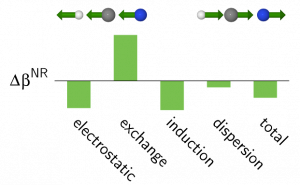Zaleśny, R.; Garcia-Borràs, M.; Góra, R. W.; Medved’, M.; Luis, J. M. Phys. Chem. Chem. Phys. 2016, 18 (32), 22467–22477 DOI: 10.1039/C6CP02500E
 This paper presents the results of a pioneering exploration of the physical origins of vibrational contributions to the interaction-induced electric properties of molecular complexes. In order to analyze the excess nuclear relaxation (hyper)polarizabilities, a new scheme was proposed which relies on the computationally efficient Bishop–Hasan–Kirtman method for determining the nuclear relaxation contributions to electric properties. The extension presented herein is general and can be used with any interaction-energy partitioning method. In this study we employed the variational–perturbational interaction-energy decomposition scheme and the extended transition state method.
This paper presents the results of a pioneering exploration of the physical origins of vibrational contributions to the interaction-induced electric properties of molecular complexes. In order to analyze the excess nuclear relaxation (hyper)polarizabilities, a new scheme was proposed which relies on the computationally efficient Bishop–Hasan–Kirtman method for determining the nuclear relaxation contributions to electric properties. The extension presented herein is general and can be used with any interaction-energy partitioning method. In this study we employed the variational–perturbational interaction-energy decomposition scheme and the extended transition state method.